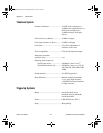
©
National Instruments Corporation B-1 NI 5911 User Manual
B
Digitizer Basics
This appendix explains basic information you need to understand about
making measurements with digitizers, including important terminology.
Understanding Digitizers
To understand how digitizers work, you should be familiar with the Nyquist
theorem and how it affects analog bandwidth and sample rate. You should
also understand terms including vertical sensitivity, analog-to-digital
converter (ADC) resolution, record length, and triggering options.
Nyquist Theorem
The Nyquist theorem states that a signal must be sampled at least twice as
fast as the bandwidth of the signal to accurately reconstruct the waveform;
otherwise, the high-frequency content will alias at a frequency inside the
spectrum of interest (passband). An alias is a false lower frequency
component that appears in sampled data acquired at too low a sampling
rate. Figure B-1 shows a 5 MHz sine wave digitized by a 6 MS/s ADC. The
dotted line indicates the aliased signal recorded by the ADC at that sample
rate.
Figure B-1.
Sine Wave Demonstrating the Nyquist Frequency
The 5 MHz frequency aliases back in the passband, falsely appearing as if
it were a 1 MHz sine wave. To prevent aliasing in the passband, a lowpass
filter limits the frequency content of the input signal above the Nyquist rate.
t
CBIHWum.book Page 1 Thursday, October 29, 1998 1:56 PM


















